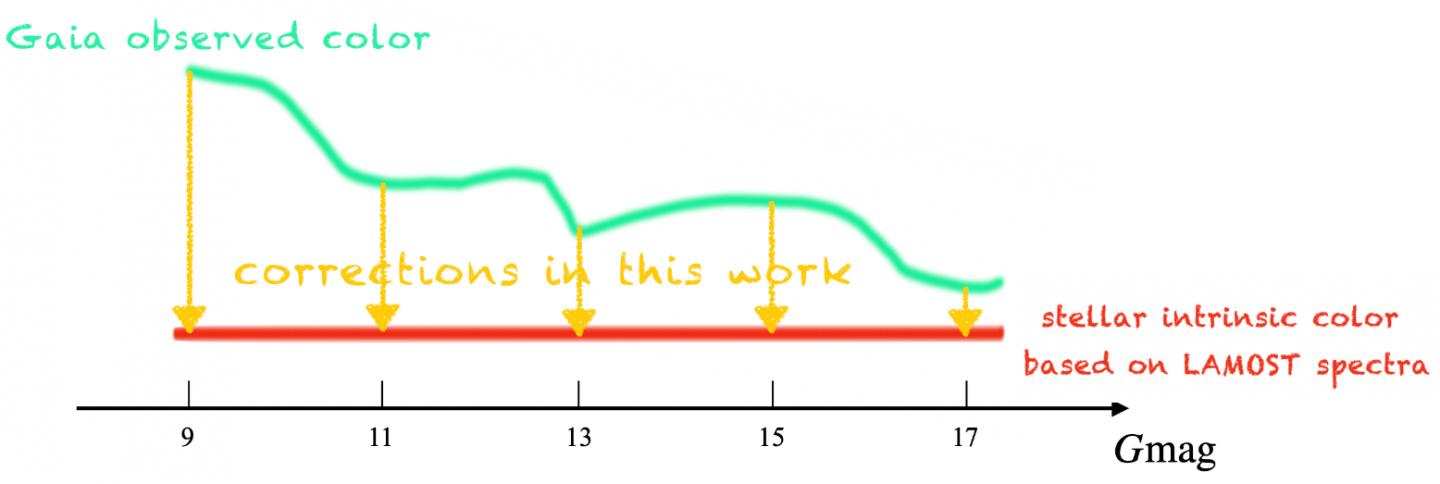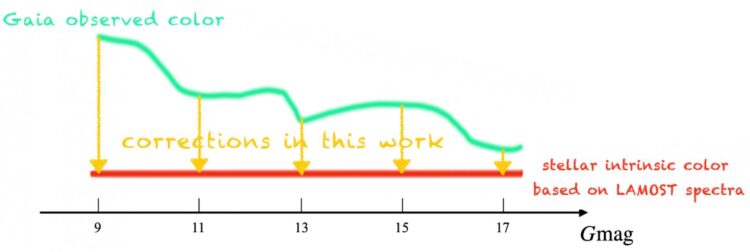
Credit: NIU Zexi
The Large Sky Area Multi-Object Fiber Spectroscopic Telescope (LAMOST) has helped Gaia achieve millimagnitude (mmag) precision in photometry, according to a study led by researchers from National Astronomical Observatories of Chinese Academy of Sciences (NAOC) and Beijing Normal University (BNU).
Their study was published in The Astrophysical Journal.
If you look at the sky on a clear, starry night, you may notice that Aldebran is relatively red and Rigel is blue. Why? The answer stems from their intrinsic physical properties. Precisely measuring magnitudes and colors helps to explain such phenomena.
The ESA Gaia satellite is well known for its remarkable capacity for astrometric observation. It delivers the most precise photometric data ever, with much higher quality than ground-based telescopes.
However, in order for Gaia to cover a wide magnitude range from 6 to 22 magnitude (mag), different observation modes have been adopted for stars of different brightness. In addition, photometric data in the G, BP, and RP bands come from different instruments and CCDs. Therefore, magnitude and color-dependent systematic errors exist.
The researchers combined two datasets, Gaia Data Release 2 (DR2) and LAMOST Data Release 5 (DR5), then selected samples of high data quality and low extinction.
The samples comprised 779,691 main-sequence stars and 71,952 red giant branch stars. Stars from 13.3 to 13.7 mag in the G band were selected as the control sample in order to establish the empirical relationship between intrinsic colors and physical parameters deduced from LAMOST.
“Applying the relationship to the whole sample, the differences between the observed colors and model-determining colors at different G magnitudes represent the color correction terms,” said Prof. LIU Jifeng from NAOC.
With the help of LAMOST’s massive stellar spectrum, the researchers used a spectroscopy-based stellar color regression method to correct systematic errors that are magnitude- and color-dependent. The relationship between the intrinsic colors and physical parameters of stars represents the key focus of this method.
By using a sample of about 500,000 stars from LAMOST and Gaia, color correction curves for the F/G/K stars are derived. “With an unprecedented precision of about 1 mmag, systematic trends in the G magnitude are revealed for both G-RP and BP-RP colors in detail,” said Prof. YUAN Haibo from BNU, the corresponding author of the study.
“Our work could be beneficial to studies where a high-precision color-color diagram is required, including the estimation of Gaia photometric metallicities, detection of peculiar objects, discrimination between binaries and single stars, and so on,” said NIU Zexi, Ph.D. candidate from NAOC and lead author of the study.
In addition, another study by the same team on color corrections for Gaia Data Early Release 3 (EDR3) was published in The Astrophysical Journal Letters.
###
Media Contact
XU Ang
[email protected]
Related Journal Article
http://dx.





